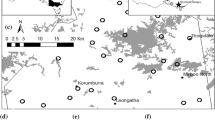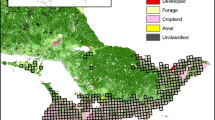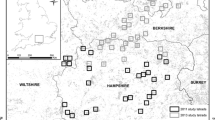Abstract
Agricultural environments have a critical role in the global conservation of biodiversity, but the persistence of forest and woodland-dependent species in these systems is often limited by insufficient habitat. Modified or semi-natural ‘countryside’ (matrix) vegetation is used by many species, but its value at the landscape scale is rarely tested. Do such habitats simply provide additional resources for populations sustained by remnant native vegetation in the landscape, or can they enhance populations over and above that sustained by natural vegetation cover? We surveyed woodland-dependent birds in all types of landscape element in 27 farmland mosaics (100 ha each) in south-eastern Australia. Four measures of wooded vegetation cover were quantified: native vegetation only; and combinations of native vegetation plus scattered trees and/or tree plantations. We used an information-theoretic approach to compare the responses of 30 species to each measure of vegetation cover. Woodland birds were well represented in agricultural mosaics (65% of the regional species-pool); however, almost half were recorded only in mosaics with >20% native vegetation cover. The incidence of 23 species was positively related to measures of wooded cover, indicating increased occurrence in mosaics with a greater cover of wooded vegetation. For 12 species, scattered trees and plantations provided supplementary habitat that enhanced their population status at the landscape scale, beyond that sustained by native vegetation cover. While native vegetation has a critical role for conservation in agricultural environments, careful management of wooded countryside elements (such as scattered trees, tree plantations) offers additional benefits to the woodland-dependent avifauna.


Similar content being viewed by others
Abbreviations
- NatVeg:
-
The total amount of relatively intact native eucalypt vegetation in study mosaics (including remnant patches and linear strips)
- IndVeg:
-
The cover of indigenous wooded vegetation in study mosaics, regardless of disturbance level (NatVeg plus scattered trees)
- DenseVeg:
-
The extent of dense wooded vegetation cover in study mosaics, regardless of canopy composition (NatVeg plus plantation)
- AllVeg:
-
The total cover of all wooded vegetation types in study mosaics (NatVeg plus scattered trees plus plantation)
References
Bennett AF, Radford JQ, Haslem A (2006) Properties of land mosaics: implications for nature conservation in agricultural environments. Biol Conserv 133:250–264
Berg A (2002) Composition and diversity of bird communities in Swedish farmland-forest mosaic landscapes. Bird Study 49:153–165
Best LB, Freemark KE, Dinsmore JJ et al (1995) A review and synthesis of habitat use by breeding birds in agricultural landscapes of Iowa. Am Midl Nat 134:1–29
Burnham KP, Anderson DR (2002) Model selection and multimodel inference: a practical information-theoretic approach. Springer, New York
Cooper CB, Walters JR (2002) Experimental evidence of disrupted dispersal causing decline of an Australian passerine in fragmented habitat. Conserv Biol 16:471–478
Cunningham RB, Lindenmayer DB, Crane M et al (2008) The combined effects of remnant vegetation and tree planting on farmland birds. Conserv Biol 22:742–752
Curry GN (1991) The influence of proximity to plantation edge on diversity and abundance of bird species in an exotic pine plantation in north-eastern New South Wales. Wildl Res 18:299–314
Deconchat M, Brockerhoff EG, Barbaro L (2009) Effects of surrounding landscape composition on the conservation value of native and exotic habitats for native forest birds. For Ecol Manag 258:S196–S204
Dunning JB, Danielson BJ, Pulliam HR (1992) Ecological processes that affect populations in complex landscapes. Oikos 65:169–175
Fischer J, Lindenmayer DB (2002a) The conservation value of paddock trees for birds in a variegated landscape in southern New South Wales. 1. Species composition and site occupancy patterns. Biodivers Conserv 11:807–832
Fischer J, Lindenmayer DB (2002b) The conservation value of paddock trees for birds in a variegated landscape in southern New South Wales. 2. Paddock trees as stepping stones. Biodivers Conserv 11:833–849
Fischer J, Fazey I, Biese R et al (2005) Making the matrix matter: challenges in Australian grazing landscapes. Biodivers Conserv 14:561–578
Fischer J, Stott J, Zerger A et al (2009) Reversing a tree regeneration crisis in an endangered ecoregion. Proc Natl Acad Sci USA 106:10386–10391
Ford HA, Barrett G (1995) The role of birds and their conservation in agricultural systems. In: Bennett AF, Backhouse GN, Clark TW (eds) People and nature conservation - perspectives on private land use and endangered species recovery. Surrey Beatty and Sons, Chipping Norton
Ford HA, Barrett GW, Saunders DA et al (2001) Why have birds in the woodlands of Southern Australia declined? Biol Conserv 97:71–88
Ford HA, Walters JR, Cooper CB et al (2009) Extinction debt or habitat change?—Ongoing losses of woodland birds in north-eastern New South Wales, Australia. Biol Conserv 142:3182–3190
Freemark KE, Merriam HG (1986) Importance of area and habitat heterogeneity to bird assemblages in temperate forest fragments. Biol Conserv 36:115–141
Friend GR (1982) Bird populations in exotic pine plantations and indigenous eucalypt forests in Gippsland, Victoria. Emu 82:80–91
Fuller RJ, Hinsley SA, Swetnam RD (2004) The relevance of non-farmland habitats, uncropped areas and habitat diversity to the conservation of farmland birds. Ibis S146:22–31
Garnett ST, Crowley GM (2000) The action plan for Australian birds 2000. Environment Australia, Canberra
Green RE, Cornell SJ, Scharlemann JPW et al (2005) Farming and the fate of wild nature. Science 307:550–555
Harvey CA, Medina A, Sanchez DM et al (2006) Patterns of animal diversity in different forms of tree cover in agricultural landscapes. Ecol Appl 16:1986–1999
Harvey CA, Komar O, Chazdon R et al (2008) Integrating agricultural landscapes with biodiversity conservation in the Mesoamerican hotspot. Conserv Biol 1:8–15
Haslem A, Bennett AF (2008a) Birds in agricultural mosaics: the influence of landscape pattern and countryside heterogeneity. Ecol Appl 18:185–196
Haslem A, Bennett AF (2008b) Countryside elements and the conservation of birds in agricultural environments. Agric Ecosyst Environ 125:191–203
Hinsley SA, Bellamy PE (2000) The influence of hedge structure, management and landscape context on the value of hedgerows to birds: a review. J Environ Manag 60:33–49
Hobbs RJ (1993) Can revegetation assist in the conservation of biodiversity in agricultural areas? Pac Conserv Biol 1:29–38
Holland GJ, Bennett AF (2010) Habitat fragmentation disrupts the demography of a widespread native mammal. Ecography 33:841–853
Hughes JB, Daily GC, Ehrlich PR (2002) Conservation of tropical forest birds in countryside habitats. Ecol Lett 5:121–129
Land Conservation Council Victoria (1982) Report on the Gippsland Lakes Hinterland Area. Government Printer, Melbourne, Australia
Law BS, Chidel M, Turner G (2000) The use by wildlife of paddock trees on farmland. Pac Conserv Biol 6:130–143
Lindenmayer DB, Hobbs RJ (2004) Fauna conservation in Australian plantation forests—a review. Biol Conserv 119:151–168
Lindenmayer DB, Cunningham RB, Donnelly CF et al (2002) Effects of forest fragmentation on bird assemblages in a novel landscape context. Ecol Monogr 72:1–18
Loyn RH, McNabb EG, Macak P et al (2007) Eucalypt plantations as habitat for birds on previously cleared farmland in south-eastern Australia. Biol Conserv 137:533–548
Luck GW (2007) The relationships between net primary productivity, human population density and species conservation. J Biogeogr 34:201–212
Luck GW, Daily GC (2003) Tropical countryside bird assemblages: richness, composition, and foraging differ by landscape context. Ecol Appl 13:235–247
Lunt ID (1997a) The distribution and environmental relationships of native grasslands on the lowland Gippsland plain, Victoria: an historical study. Aust Geogr Stud 35:140–152
Lunt ID (1997b) Effects of long-term vegetation management on remnant grassy forests and anthropogenic native grasslands in south-eastern Australia. Biol Conserv 81:287–297
Mac Nally R, Bennett AF, Thomson JR et al (2009) Collapse of an avifauna: climate change appears to exacerbate habitat loss and degradation. Divers Distrib 15:720–730
MacHunter J, Wright W, Loyn R et al (2006) Bird declines over 22 years in forest remnants in southeastern Australia: evidence of faunal relaxation? Can J For Res 36:2756–2768
Major RE, Christie FJ, Gowing G et al (1999) Age structure and density of red-capped robin populations vary with habitat size and shape. J Appl Ecol 36:901–908
Manning AD, Lindenmayer DB, Barry SC (2004) The conservation implications of bird reproduction in the agricultural “matrix”: a case study of the vulnerable superb parrot of south-eastern Australia. Biol Conserv 120:363–374
Manning AD, Fischer J, Lindenmayer DB (2006) Scattered trees are keystone structures—implications for conservation. Biol Conserv 132:311–321
McGarigal K, McComb WC (1995) Relationships between landscape structure and breeding birds in the Oregon Coast Range. Ecol Monogr 65:235–260
McIntyre S, Barrett GW (1992) Habitat variegation, an alternative to fragmentation. Conserv Biol 6:146–147
McIntyre S, Hobbs R (1999) A framework for conceptualizing human effects on landscapes and its relevance to management and research models. Conserv Biol 13:1282–1292
Miller JR, Cale P (2000) Behavioural mechanisms and habitat use by birds in a fragmented agricultural landscape. Ecol Appl 10:1732–1748
Munro NT, Lindenmayer DB, Fischer J (2007) Faunal response to revegetation in agricultural areas of Australia: a review. Ecol Manag Restor 8:199–207
Petit LJ, Petit DR, Christian DG et al (1999) Bird communities of natural and modified habitats in Panama. Ecography 22:292–304
R Development Core Team (2009) R: a language and environment for statistical computing. R Foundation for Statistical Computing, Vienna
Radford JQ, Bennett AF (2005) Terrestrial avifauna of the Gippsland Plain and Strzelecki Ranges, Victoria, Australia: insights from Atlas data. Wildl Res 32:531–555
Radford JQ, Bennett AF (2007) The relative importance of landscape properties for woodland birds in agricultural landscapes. J Appl Ecol 44:737–747
Radford JQ, Bennett AF, Cheers GJ (2005) Landscape-level thresholds of habitat cover for woodland-dependent birds. Biol Conserv 124:317–337
Renjifo LM (1999) Composition changes in a Subandean avifauna after long-term forest fragmentation. Conserv Biol 13:1124–1139
Renjifo LM (2001) Effect of natural and anthropogenic landscape matrices on the abundance of Subandean bird species. Ecol Appl 11:14–31
Ryan PA (1999) The use of revegetation areas by vertebrate fauna in Australia: a review. In: Hobbs RJ, Yates CJ (eds) Temperate eucalypt woodlands in Australia: biology, conservation, management and restoration. Surrey Beatty and Sons, Chipping Norton
Scharlemann JPW, Green RE, Balmford A (2004) Land-use trends in endemic bird areas: global expansion of agriculture in areas of high conservation value. Glob Change Biol 10:2046–2051
Sekercioglu CH, Loarie SR, Brenes FO et al (2007) Persistence of forest birds in the Costa Rican agricultural countryside. Conserv Biol 21:482–494
Tilman D, Fargione J, Wolff B et al (2001) Forecasting agriculturally driven global environmental change. Science 292:281–284
Trzcinski MK, Fahrig L, Merriam G (1999) Independent effects of forest cover and fragmentation on the distribution of forest breeding birds. Ecol Appl 9:586–593
Vandermeer J, Perfecto I (2007) The agricultural matrix and a future paradigm for conservation. Conserv Biol 21:274–277
Venables WN, Ripley BD (2002) Modern applied statistics with S. Springer, New York
Vesk PA, Mac Nally R (2006) The clock is ticking—revegetation and habitat for birds and arboreal mammals in rural landscapes of Southern Australia. Agric Ecosyst Environ 112:356–366
Ward WT (1977) Geomorphology and soils of the Stratford-Bairnsdale area, East Gippsland. Australia. CSIRO, Melbourne, Australia
Acknowledgements
Financial assistance for this research has been received from Deakin University, Holsworth Wildlife Research Endowment, and Australian Landscape Trust. We thank the numerous landholders who provided access to their properties, and Greg Holland for statistical advice. This research was undertaken in accordance with Deakin University Ethics Permit A35/2005 and DSE Research Permit 10002837. Editorial staff and two reviewers provided useful comments on this manuscript.
Author information
Authors and Affiliations
Corresponding author
Rights and permissions
About this article
Cite this article
Haslem, A., Bennett, A.F. Countryside vegetation provides supplementary habitat at the landscape scale for woodland birds in farm mosaics. Biodivers Conserv 20, 2225–2242 (2011). https://doi.org/10.1007/s10531-011-0084-2
Received:
Accepted:
Published:
Issue Date:
DOI: https://doi.org/10.1007/s10531-011-0084-2




